+ Open data
Open data
- Basic information
Basic information
| Entry | Database: PDB / ID: 3wtf | ||||||
|---|---|---|---|---|---|---|---|
| Title | Structure of PAXX | ||||||
 Components Components | Uncharacterized protein C9orf142 | ||||||
 Keywords Keywords |  IMMUNE SYSTEM / IMMUNE SYSTEM /  DNA repair / DNA repair /  Scaffold Scaffold | ||||||
| Function / homology |  Function and homology information Function and homology information nonhomologous end joining complex / nonhomologous end joining complex /  DNA polymerase binding / double-strand break repair via nonhomologous end joining / site of double-strand break / molecular adaptor activity / DNA damage response / protein homodimerization activity / DNA polymerase binding / double-strand break repair via nonhomologous end joining / site of double-strand break / molecular adaptor activity / DNA damage response / protein homodimerization activity /  nucleoplasm / identical protein binding / nucleoplasm / identical protein binding /  nucleus / nucleus /  cytoplasm cytoplasmSimilarity search - Function | ||||||
| Biological species |   Homo sapiens (human) Homo sapiens (human) | ||||||
| Method |  X-RAY DIFFRACTION / X-RAY DIFFRACTION /  SYNCHROTRON / SYNCHROTRON /  MOLECULAR REPLACEMENT / Resolution: 3.451 Å MOLECULAR REPLACEMENT / Resolution: 3.451 Å | ||||||
 Authors Authors | Ochi, T. / Blundell, T.L. | ||||||
 Citation Citation |  Journal: Science / Year: 2015 Journal: Science / Year: 2015Title: DNA repair. PAXX, a paralog of XRCC4 and XLF, interacts with Ku to promote DNA double-strand break repair. Authors: Ochi, T. / Blackford, A.N. / Coates, J. / Jhujh, S. / Mehmood, S. / Tamura, N. / Travers, J. / Wu, Q. / Draviam, V.M. / Robinson, C.V. / Blundell, T.L. / Jackson, S.P. | ||||||
| History |
|
- Structure visualization
Structure visualization
| Structure viewer | Molecule:  Molmil Molmil Jmol/JSmol Jmol/JSmol |
|---|
- Downloads & links
Downloads & links
- Download
Download
| PDBx/mmCIF format |  3wtf.cif.gz 3wtf.cif.gz | 108 KB | Display |  PDBx/mmCIF format PDBx/mmCIF format |
|---|---|---|---|---|
| PDB format |  pdb3wtf.ent.gz pdb3wtf.ent.gz | 83.6 KB | Display |  PDB format PDB format |
| PDBx/mmJSON format |  3wtf.json.gz 3wtf.json.gz | Tree view |  PDBx/mmJSON format PDBx/mmJSON format | |
| Others |  Other downloads Other downloads |
-Validation report
| Arichive directory |  https://data.pdbj.org/pub/pdb/validation_reports/wt/3wtf https://data.pdbj.org/pub/pdb/validation_reports/wt/3wtf ftp://data.pdbj.org/pub/pdb/validation_reports/wt/3wtf ftp://data.pdbj.org/pub/pdb/validation_reports/wt/3wtf | HTTPS FTP |
|---|
-Related structure data
| Related structure data |  3wtdSC S: Starting model for refinement C: citing same article ( |
|---|---|
| Similar structure data |
- Links
Links
- Assembly
Assembly
| Deposited unit | 
| ||||||||
|---|---|---|---|---|---|---|---|---|---|
| 1 |
| ||||||||
| Unit cell |
|
- Components
Components
| #1: Protein | Mass: 21807.629 Da / Num. of mol.: 2 Source method: isolated from a genetically manipulated source Source: (gene. exp.)   Homo sapiens (human) / Gene: C9orf142 / Plasmid: pHAT4 / Production host: Homo sapiens (human) / Gene: C9orf142 / Plasmid: pHAT4 / Production host:   Escherichia coli (E. coli) / Strain (production host): BL21(DE3) / References: UniProt: Q9BUH6 Escherichia coli (E. coli) / Strain (production host): BL21(DE3) / References: UniProt: Q9BUH6#2: Water | ChemComp-HOH / |  Water Water |
|---|
-Experimental details
-Experiment
| Experiment | Method:  X-RAY DIFFRACTION / Number of used crystals: 1 X-RAY DIFFRACTION / Number of used crystals: 1 |
|---|
- Sample preparation
Sample preparation
| Crystal | Density Matthews: 2.01 Å3/Da / Density % sol: 38.81 % |
|---|---|
Crystal grow | Temperature: 291 K / Method: vapor diffusion, hanging drop / pH: 6 Details: 1M sodium malonate, 1% (v/v) 1,4-Dioxane, pH 6.0, VAPOR DIFFUSION, HANGING DROP, temperature 291K |
-Data collection
| Diffraction | Mean temperature: 100 K |
|---|---|
| Diffraction source | Source:  SYNCHROTRON / Site: SYNCHROTRON / Site:  Diamond Diamond  / Beamline: I03 / Wavelength: 0.97625 Å / Beamline: I03 / Wavelength: 0.97625 Å |
| Detector | Type: DECTRIS PILATUS 6M-F / Detector: PIXEL / Date: May 18, 2013 |
| Radiation | Monochromator: Si 111 / Protocol: SINGLE WAVELENGTH / Monochromatic (M) / Laue (L): M / Scattering type: x-ray |
| Radiation wavelength | Wavelength : 0.97625 Å / Relative weight: 1 : 0.97625 Å / Relative weight: 1 |
| Reflection | Resolution: 3.45→24.47 Å / Num. obs: 4986 / % possible obs: 97.3 % / Redundancy: 6.1 % / Rsym value: 0.088 / Net I/σ(I): 9.1 |
| Reflection shell | Resolution: 3.45→3.78 Å / Redundancy: 5.9 % / Mean I/σ(I) obs: 1.7 / Num. unique all: 1150 / Rsym value: 0.599 / % possible all: 98.2 |
- Processing
Processing
| Software |
| |||||||||||||||||||||||||||||||||||||||||||||||||||||||||||||||||||||||||||
|---|---|---|---|---|---|---|---|---|---|---|---|---|---|---|---|---|---|---|---|---|---|---|---|---|---|---|---|---|---|---|---|---|---|---|---|---|---|---|---|---|---|---|---|---|---|---|---|---|---|---|---|---|---|---|---|---|---|---|---|---|---|---|---|---|---|---|---|---|---|---|---|---|---|---|---|---|
| Refinement | Method to determine structure : :  MOLECULAR REPLACEMENT MOLECULAR REPLACEMENTStarting model: 3WTD Resolution: 3.451→24.47 Å / SU ML: 0.52 / σ(F): 1.34 / Phase error: 35.76 / Stereochemistry target values: ML
| |||||||||||||||||||||||||||||||||||||||||||||||||||||||||||||||||||||||||||
| Solvent computation | Shrinkage radii: 0.9 Å / VDW probe radii: 1.11 Å / Solvent model: FLAT BULK SOLVENT MODEL | |||||||||||||||||||||||||||||||||||||||||||||||||||||||||||||||||||||||||||
| Refinement step | Cycle: LAST / Resolution: 3.451→24.47 Å
| |||||||||||||||||||||||||||||||||||||||||||||||||||||||||||||||||||||||||||
| Refine LS restraints |
| |||||||||||||||||||||||||||||||||||||||||||||||||||||||||||||||||||||||||||
| LS refinement shell | Refine-ID: X-RAY DIFFRACTION / Total num. of bins used: 4
| |||||||||||||||||||||||||||||||||||||||||||||||||||||||||||||||||||||||||||
| Refinement TLS params. | Method: refined / Refine-ID: X-RAY DIFFRACTION
| |||||||||||||||||||||||||||||||||||||||||||||||||||||||||||||||||||||||||||
| Refinement TLS group |
|
 Movie
Movie Controller
Controller



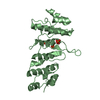
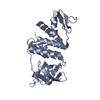




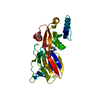
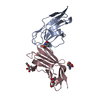
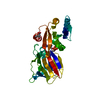

 PDBj
PDBj
